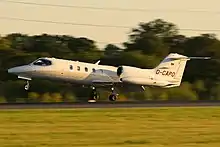1996 New Hampshire Learjet crash
The 1996 New Hampshire Learjet crash involved a Learjet 35A which disappeared on Christmas Eve 1996 near Dorchester, New Hampshire, in the United States. The crash led to the longest missing aircraft search in the state's history, lasting almost three years.[1] Media attention eventually resulted in Congressional legislation mandating improved Emergency locator transmitters (ELT) be installed in U.S.-registered business jets.[2]
 A Learjet 35A similar to the accident aircraft | |
| Accident | |
|---|---|
| Date | 24 December 1996 |
| Summary | Controlled flight into terrain due to loss of situation awareness and crew error |
| Site | Dorchester, New Hampshire 43°49.56′N 72°00.75′W |
| Aircraft | |
| Aircraft type | Learjet 35A |
| Operator | Aircraft Charter Group, Inc. |
| Registration | N388LS |
| Flight origin | Bridgeport, Connecticut |
| Destination | Lebanon, New Hampshire |
| Passengers | 0 |
| Crew | 2 |
| Fatalities | 2 |
| Survivors | 0 |
Crash information
The aircraft involved, registration N388LS, was operated by the Aircraft Charter Group and flown by pilots Johan Schwartz and Patrick Hayes for a repositioning flight to Lebanon, New Hampshire. They left Sikorsky Memorial Airport in Bridgeport, Connecticut at 09:19am and 25 minutes later were flying the approach into Lebanon Municipal Airport. After one attempt at the ILS approach, the crew reported that they were unable to receive the localizer, when they were actually several miles off course. They presumed ground equipment failure, and the pilot told the tower that he was executing a missed approach. The aircraft's last radar contact was as it proceeded outbound, seven nautical miles (13 km) northeast of the VOR, at 4,800 ft (1,500 m).[3] As the business jet neared the inbound course to the VOR, the captain called out the outer marker. The first officer agreed, and the captain stated that they could descend to 2,300 feet. Shortly thereafter, the first officer stated that he was descending the aircraft to 2,300 feet. Three seconds later, the Learjet impacted trees, then terrain. The wreckage was located at an altitude of 2,300 feet, on rising mountainous terrain, 061 degrees magnetic, 12.5 nautical miles from the VOR. It was raining and foggy at the time.
Searches were mounted, unsuccessfully. The wreckage was found near Smarts Mountain almost three years later, on November 13, 1999, about 20 miles (32 km) from the airport. Debris was spread over a 150-yard (140 m) area in dense forest. The aircraft had descended into the ground 10.3 nautical miles (19.1 km) earlier than normal.
The cause of the accident was listed as:
The captain's failure to maintain situational awareness, which resulted in the airplane being outside the confines of the instrument approach; and the crew's misinterpretation of a step-down fix passage, which resulted in an early descent into rising terrain. Factors included the captain's misreading of the instrument approach procedure, the crew's rushed and incomplete instrument approach briefing, their failure to use additional, available navigational aids, and their failure to account for the winds at altitude.[4]
ELT implications
The crashed aircraft had no Emergency Locator Transmitter (ELT) on board, as that class of aircraft when used for FAR Part 135 charter operations, was exempt from the Federal requirements for this type of beacon. As a result, Congress directed the FAA to require the installation of 406 MHz ELTs in all business jets (replacing the 121.5 MHz units installed in some).[5]
See also
- 1947 BSAA Avro Lancastrian Star Dust accident
- Uruguayan Air Force Flight 571
- Cockpit voice recorder (CVR)
- Controlled flight into terrain (CFIT)
- Emergency position-indicating radiobeacon station (EPIRS)
- Ground proximity warning system (EGPWS)
- Instrument approach
- National Transportation Safety Board (NTSB)
- Standard Operating Procedure (SOP)
References
- Ferns, Jack (Summer 2006). "From the Cockpit" (PDF). The Aeronaut. New Hampshire Aviation Historical Society.
- Pope, Stephen (March 2004). "Cabin & Cockpit Avionics". Aviation International News. Archived from the original on 5 June 2004.
- Detailed NTSB report of the crash
- NTSB accident brief
- "US business jets grounded as FAA transmitter mandate takes effect". Flight Global. January 6, 2004. Retrieved October 11, 2015.